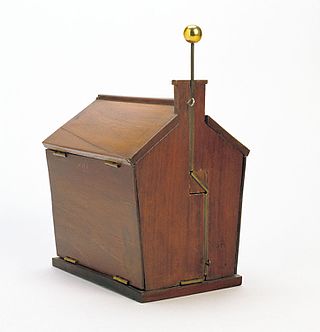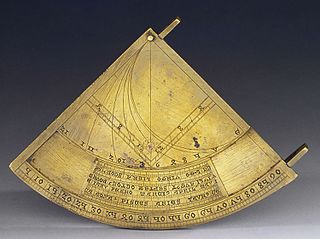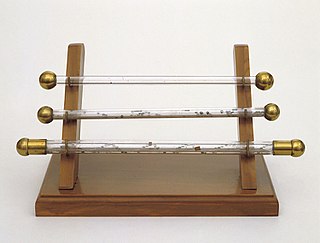
Museo Galileo is located in Florence, Italy, in Piazza dei Giudici, along the River Arno and close to the Uffizi Gallery. The museum, dedicated to astronomer and scientist Galileo Galilei, is housed in Palazzo Castellani, an 11th-century building which was then known as the Castello d'Altafronte.

Fabio Colonna was an Italian naturalist and botanist.
Paolo Galluzzi is an Italian historian of science.

The Old Fortress of Livorno is a castle in Livorno, Italy. The Old Fortress is a successor building to a medieval fort built by the city of Pisa in the location of an older keep built by Countess Matilda of Tuscany in the 11th century. The 11th century tower was incorporated inside the fort built by the Pisans. The castle has been described as a "symbol of Medicean Livorno". The fort is located at the Medicean Darsena, or old dock of the port of Livorno, built by the Medici family. The ceremony proclaiming Livorno a city took place inside the fortress on 19 March 1606.
Francesco Comelli was an Italian scientific instrument maker with considerable expertise in foundry and metalworking.

The jovilabe is a brass scientific instrument, undated and of unknown maker, currently in the collection of the Museo Galileo in Florence, Italy.

Galileo's objective lens is a specific objective lens held in the Museo Galileo, Florence, Italy. It was used by Galileo Galilei in the Galilean telescope with which he discovered the four largest moons of Jupiter in 1610. The lens has a diameter of 38mm and a gilt brass housing. The frame is made of ebony and ivory and has dimensions of 410mm x 300mm.
The Campani compound microscope is a microscope on exhibit at the Museo Galileo in Italy, thought to have been built by optical instrument maker Giuseppe Campani in the second half 17th century. For a time it was thought to have been built by Italian scientist Galileo Galilei but no longer bares that attribution.

The thunder house is a scientific model invented by James Lind which gives a spectacular demonstration of the destructive effect of a lightning bolt striking a house with an imperfect lightning conductor.

The Quadrans Vetus is a medieval astronomical instrument.

The Instrument of the Primum Mobile is also called the quadrant of Petrus Apianus, because he invented it and described it in the treatise Instrumentum primi mobilis. The instrument is used to find sines and cosines. It bears the initials "F.E.D.P.F." [Frater Egnatius Dantis Predicatorum Fecit]. Ignazio Danti dedicated it to Cosimo I de' Medici, as attested by the Medici coat of arms engraved on the front. The instrument was depicted on the ceiling of the Stanzino delle Matematiche in the Uffizi Gallery.

The Tabula Affinitatum is a table of chemical affinities between substances.

The tall-stem thermometers are a kind of thermometer, resting on branched feet.

The frog thermometer or - as the Cimento academicians defined it, the botticino [small-toad] thermometer - contained small glass spheres of different density, which were immersed in alcohol. The device was used as a clinical thermometer, tied to the wrist or the arm of the patient with the head of the frog facing upward. The variations in body temperature were registered by the movement of the spheres. The rise in temperature causes an increase in the volume of the alcohol, reflected in the movement of the small spheres. Because of the spheres' sluggish motion, this thermometer was also called infingardo [slothful, slow]. The invention of this model is attributed to Ferdinand II de' Medici.

The luminous discharge tube is part of an electric machine.

The elastic and inelastic collisions apparatus is a large apparatus to study elastic and inelastic collisions.

The mechanical paradox is an apparatus for studying physical paradoxes. It consists of a trapezoidal veneered wooden frame with two brass rails, and a pair of brass cones joined at their bases by a wooden disk which rests on the rails. When the double cone is placed at the low end of the frame, it automatically starts to roll upward, giving the impression of escaping the universal law of the gravitational force.

The Reale Museo di Fisica e Storia Naturale was an Italian museum founded on 22 February 1775 in Florence that survived until 1878, when its collections were split up in various Florentine museums.
Nuncius: Journal of the Material and Visual History of Science is a triannual peer-reviewed academic journal covering the history of science, especially the "historical role of material and visual culture in science". The journal was established in 1976 by Maria Luisa Righini Bonelli as the Annali dell'Istituto e Museo di storia della scienza di Firenze. The journal changed its publisher in 2011. It is published by Brill Publishers and the editor-in-chief is Elena Canadelli of the University of Padua, Italy.

Giorgio Coresio (1570-1659?) from the Greek island of Chios was a lecturer in Greek at the University of Pisa from 1609-1615. He was obliged to resign his chair either because it was discovered that he secretly professed the Greek Orthodox faith, or because of his mental illness - he is said to have had daily visions of saints.
















